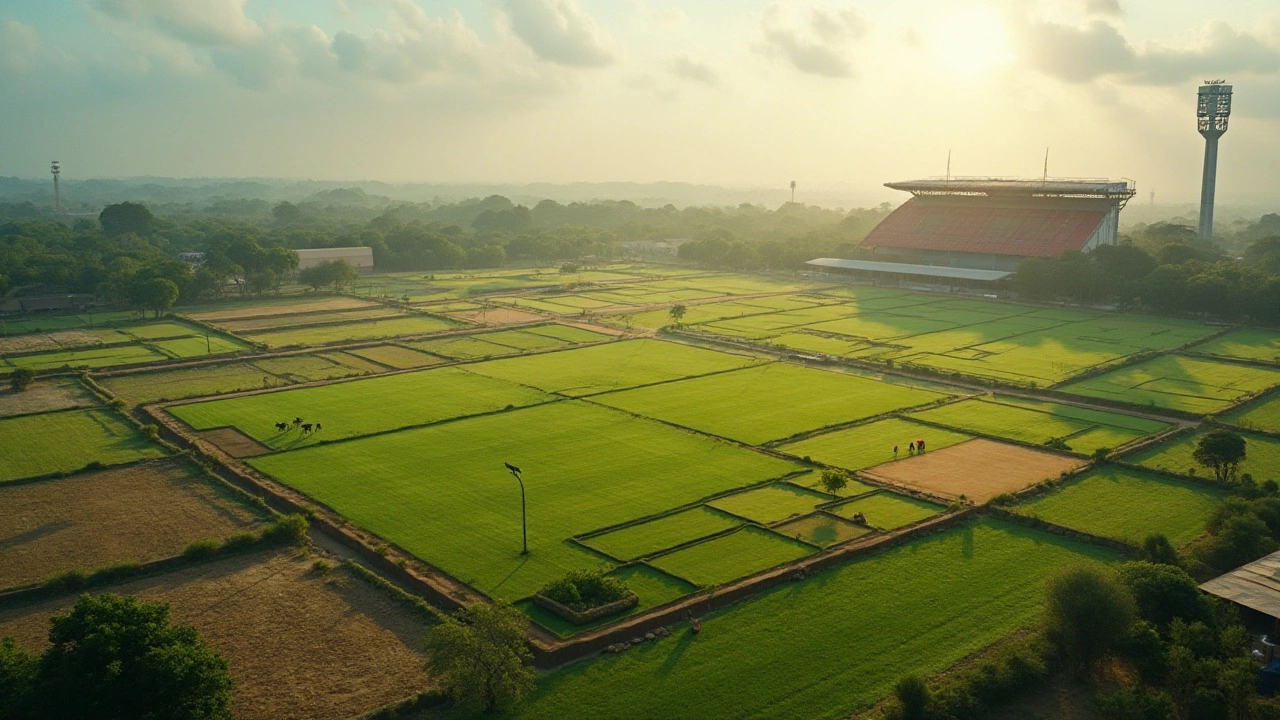When it comes to land size, numbers alone might not always convey the true sense of scale. Often, visual comparisons help anchor abstract figures into something more relatable and tangible. Picture yourself standing in the middle of a vast open field, trying to gauge the size — that's where comparisons like 'how many football fields fit into an acre' come into play.
In this article, let's delve into what 20 acres actually mean by using something most of us are familiar with: the size of a football field. Through this exploration, you'll gain not only a better understanding of land size but also some practical insights on how such comparisons can significantly aid in the process of buying or evaluating land.
- Understanding Acres
- The Size of a Football Field
- Comparing 20 Acres to Football Fields
- Why Size Comparisons Matter
- Visualizing 20 Acres
- Practical Tips for Assessing Land Size
Understanding Acres
Imagine trying to measure the vast expanse of land where numbers alone seem abstract, and the real task is grasping their scale. That's where the concept of an acre comes into play, acting almost like an anchor in the sea of land measurements. An acre provides a standardized way to assess land, giving buyers, sellers, and assessors a mutual understanding of size and space. But what exactly is an acre? Traditionally, an acre is described as an area of land that is one furlong long and one chain wide. This might seem a bit outdated, harking back to medieval times when agricultural practices dictated land division, but it's stuck around for good reason.
In modern terms, one acre translates to 43,560 square feet. It’s said that an acre originally represented the amount of land tillable by one man behind an ox in one day. This telling piece of history emphasizes not just the physical size but also the effort and the reward tied to working the land. The imperial roots of the acre also mean it’s predominantly used in countries like the United States, whereas many other parts of the world have shifted to the metric hectare, which measures about 2.47 acres. Understanding these conversions, particularly if you're browsing international real estate, can be quite crucial.
The Origin and Evolution
Today, the acre still serves as a foundation in defining plots, especially in places with agriculture as the backbone. But why did it stick around through centuries of land transformation and development? Its adaptability and straightforwardness are key. An acre can mold into any shape — be it a rectangle, a square, or any other design you dream of in real estate. This flexibility helps in real-world scenarios where land is rarely perfectly rectangular. It’s practical, and it makes planning easier.
"The acre is a size humans can comfortably comprehend, a nod to our agrarian past." — Land Management Scholar
Though an acre is a fixed number of square feet, how it manifests on the ground can vary widely. One might envision a sprawling landscape with trees and open fields, while another sees a densely packed urban plot. This versatility makes it essential for potential land buyers to understand precisely what one acre means to them. Whether it’s for a homestead, agriculture, or commercial development, comprehending the size and scope of an acre is an integral step in the process.
One interesting fact to ponder on is that the measurement of an acre hasn’t lost relevance even as technology revolutionizes mapping and surveying. With advanced GIS (Geographic Information Systems) technology, acres are easier than ever to measure, visualize, and analyze. This old unit of measurement is improved upon with tech innovations without losing its core simplicity and practicality.
The Size of a Football Field
A football field is often used as a unit of measure for large areas because it's a commonly understood standard. The typical American football field, including the end zones, measures about 360 feet long and 160 feet wide, which adds up to 57,600 square feet. This precise measurement has been universally accepted, making it a helpful visual tool for comparing sizes, not just in sports but in real estate and other fields as well.
To break this down into more familiar numbers, a standard football field is equivalent to roughly 1.32 acres of land. When you're trying to picture acres, envision how a football field might cover that ground. The sheer area of a football field brings to mind sprawling green expanses — useful imagery to bring abstract measurements into focus. Considering this conversion, it's evident how football fields help us comprehend much larger areas by dividing them into smaller, easier-to-visualize components.
Interestingly, the tradition of using a football field as a measure extends to its historical roots, from its inception in collegiate sports in the late 19th century to its adoption in professional leagues. This uniformity helps paint a vivid picture when discussing large areas, like comparing a few acres or even a sprawling estate. Its utility isn't just anecdotal; land surveyors, urban planners, and even educators often rely on this unit.
"Using widely recognized units like the size of a football field makes communicating about land sizes accessible to the layperson without relying on specialized jargon," says Jane Doe, a seasoned real estate analyst.
If you're assessing land size comparisons, keeping the football field in mind can serve as a reference point. For those unfamiliar with acres, this visualization transforms a number on a page into a snapshot of lush, expansive landscapes. The metaphor evolves into a practical tool when comparing distances for potential land purchases or simply understanding property listings. Through this lens, football fields bridge the gap between technicality and tangibility, helping buyers and sellers make informed decisions.

Comparing 20 Acres to Football Fields
To truly grasp how expansive 20 acres of land is, comparing it to something familiar like a football field provides clarity. In the United States, a traditional football field, including the end zones, measures approximately 57,600 square feet or 1.32 acres. To envision the breadth of 20 acres, you would imagine roughly 15.15 football fields laid out side by side. This comparison is powerful because it helps visualize the land's breadth in terms you can walk across, experience, and see with your own eyes every fall weekend on sports channels.
Considering the vastness of 20 acres can spark daydreams bordered only by imagination. For perspective, imagine a football playoff where every match began on sovereign plots of 1.32 acres; now picture 15 matches simultaneously, each cast on its own section of rolling greenery. That's approximately how vast 20 acres resemble in contiguous space. This practical visualization aids in conceptualizing not just where boundaries lie, but what such a hefty slice of earth could become under your stewardship — whether it's agricultural pursuits, a new residential estate, or simply a haven of untamed nature.
Moreover, think of events hosted across similar dimensions — music festivals, outdoor racetracks, or wildlife preserves. The field's measure becomes not only a reference but a canvas for creative utility and ambitious pursuits. Land developers often layer this comparison into pitches because it offers vivid illustrations of possibility — factoring into both town planning conversations and personal backyard contemplation alike.
In a world that measures and prices land in ways akin to precious metals, knowing exactly how many football fields a parcel could hold has real-world implications. For those considering a purchase of such sizable land, grasping the visual scale helps determine future possibilities. A
lot of people miss this kind of large-scale comparison before buying property, and it makes all the difference when you're deciding how to plan or even dream about the land's potential.This touch of realism mixed with fantasy paves the path for informed decisions.
Land as a Versatile Canvas
Imagine the transformation! On a canvas spanning 20 acres, you wield the brush. The versatile expanse could accommodate a semi-private neighborhood of luxurious homes, each flanked by its own personal quarters of greenery. Alternatively, envision rows upon rows of crops swaying gently under the relentless kiss of the summer sun. Agricultural endeavors are as feasible as the elaborate planning of suburban lifestyle blocks.
The significance of these twenty spacious, sprawling acres extends beyond numbers. It’s potential energy waiting to be transformed into kinetic masterwork. Think of collating an agricultural masterclass in mixed crop production, or nurturing a farm-to-table experience that feeds not only the body but the soul of a community. The potential is there, pallet blank, inviting artistry that molds land to meet contemporary needs while preserving natural sanctity.
Why Size Comparisons Matter
When it comes to understanding land measurement, the sheer abstract nature of acre measurements can leave many of us scratching our heads. A size comparison is vital as it bridges the gap between unfamiliar numbers and familiar, relatable images. This is where comparing land to something as universally understood as a football field becomes incredibly useful. The average person might not know how large an acre is just from hearing the term. However, they can certainly imagine the size of a football field, which paints a clearer mental picture. When discussing something as significant as land size comparison, being able to visualize it is almost as important as knowing the exact measurements on paper.
The comparison doesn't just help buyers grasp an abstract unit of measurement; it also provides a practical reference when considering the possible uses of the space. For instance, knowing that 20 acres accommodate around 15 football fields helps potential buyers decide whether a plot is suitable for their intended use. Whether for building homes, creating a playground, or farming, the ability to convert acres into tangible visuals aids in gauging the feasibility of different projects. Consequently, it can have critical financial implications, ensuring that buyers invest wisely in land that truly meets their needs.
One might imagine themselves walking from one end of a football field to the other and then multiplying that distance by 15 to toggle on the sheer size of 20 acres. It provides a concrete example of whether the property can fit all the envisioned constructions, be it several homes with spacious lawns or a sprawling agricultural landscape. Using these scales also make negotiations smoother as both buyers and sellers have a mutual understanding of what is being discussed. A quote from renowned real estate developer Sam Zell captures this notion:
"Understanding the ground beneath your feet is more than just a number; it’s about knowing its potential.”
In addition, size comparisons become educational for those unfamiliar with large-scale land purchases or those new to the real estate market. Consider a novice investor who has never had the opportunity to deal with multiple acres of land. Comparing it to a football field gives them a familiar baseline to start asking the right questions and conducting the necessary due diligence. This foundational knowledge can be pivotal in making informed decisions and avoiding costly mistakes.

Visualizing 20 Acres
Imagining the expanse of 20 acres might require a bit of creative thinking, as it's a size not easily encountered in everyday life. To give you a clearer perspective, think of a football field. A standard American football field, including its end zones, covers about 1.32 acres. With some quick math, you’ll realize that 20 acres equate to roughly 15 full-sized football fields laid out side by side. It’s a bit like standing at the center of a massive grid, imagining each segment as the familiar green of a field, stretching into the distance. This comparison can make the idea of acres a little less abstract and a lot more relatable. In the context of developing property or planning land use, these dimensions offer a compelling vision of potential.
Consider the variety of uses that such a significant area can accommodate. Envision the endless possibilities: sprawling gardens, expansive farming plots, or even multiple sports fields. The key to fully appreciating 20 acres is breaking it down into smaller, more familiar parcels and understanding how they might fit into your unique vision. With ample room for maneuver, imagine integrating different elements harmoniously, like combining agricultural areas with personal recreational spaces.
There's more than personal creativity at play when viewing land this size. According to the U.S. Department of Agriculture's land use survey, owning large plots could also offer significant financial benefits. A diversified piece of land can yield income streams, perhaps through crops or livestock, alongside personal uses. It’s an investment that serves not only personal ambitions but practical futures. As renowned land investor and author Robert Kiyosaki once said,
"Real estate investing, even on a very small scale, remains a tried and true means of building an individual's cash flow and wealth."
For a practical application, you might consider subdividing your 20 acres into sections for various purposes. You can reserve a couple of acres for building, keeping the rest for farming or leasing. This kind of division requires strategic planning but offers the flexibility of use that makes an investment worthwhile. You can optimize this link between the size of your land and its potential functionality, enhancing your satisfaction and returns.
Given such flexibility, 20 acres can also serve conservation purposes, integrating wildlife preservation with modern living. Constructing a home that respects and harmonizes with nature can create a sanctuary of biodiversity. Understanding this scale through its parallel in football fields not only helps in planning but also inspires visions of sustainability and coexistence with natural landscapes. Having this vast amount of space is more than ownership; it’s stewardship of both resources and potential.
The implications of evaluating land size this way mean kickstarting a creative process, where laying out plans beautifully complements your objectives. Whether it’s a playground for the imagination or a carefully mapped out investment, visualizations play a pivotal role in transforming 20 acres from numbers on paper to a terrain thriving with possibility. Consider each acre not just an area, but a canvas waiting for your vision to take form, setting the stage for future possibilities.
Practical Tips for Assessing Land Size
When you're considering purchasing land or evaluating a potential piece of property, having a clear sense of its actual size is crucial. Visualizing the expanse of land size can sometimes feel like trying to grasp something intangible, especially if your experience with land is primarily confined to urban settings or smaller plots. Let’s explore some practical strategies for assessing land size effectively by utilizing relatable measurements and a bit of legwork.
One straightforward approach to assessing land measurement is by using tools that offer aerial maps or satellite views. Platforms like Google Earth or GIS maps can help you visualize the area from a bird's-eye view, giving you a solid starting point. You can even draw boundary lines and measure distances visually. This is particularly useful when comparing large plots, like 20 acres, since the visuals can often help bridge the gap between imagination and reality. On the tech side, you might consider apps that convert measurements into understandable comparisons, such as acres to football fields, which can instantly make the scale more relatable.
Another method is to visit the land and physically walk the boundaries. Walking the perimeter provides not just a concrete sense of space but also an opportunity to engage with the land on a tactile level. Pay attention to how long it takes to traverse the plot; this can be telling in terms of its actual expanse. A practical tip is to use a pedometer or a smartphone app that tracks distance as you walk, calculating the length around the plot. If the area feels larger than expected, consider what might be influencing that impression, such as topographical variations or obstacles like trees and brush that alter perception.
Understanding Terrain and Boundaries
It's also essential to consider the terrain and boundaries of the land. Is the land flat or hilly? Are there any natural water features, rocky outcrops, or dense forestry that might affect the usage of the land? Knowing these features can significantly change how you perceive space. Engaging with a local land surveyor can give you professional insights, adding layers of information to what you physically observe. This professional guidance can be invaluable, particularly when dealing with large stretches of land.
Often, local anecdotal evidence or lore about the land can also lend a deeper understanding. Speaking with neighbors or local experts can reveal history and idiosyncrasies of the area that aren't immediately visible. As Jane Smith, a well-known real estate developer, once said:
”Understanding land is not just about seeing it; it's about engaging with its stories and potential.”These stories might pertain to how land use affects perceptions, a view echoed across many rural communities where acres are the currency of conversation.
Finally, considering how you plan to use the land can affect how you should assess its size. Are you planning agricultural development, or is it for a housing project? Different uses require different amounts of space and infrastructure, which in turn can challenge your initial sense of scale. Create a vision board or a digital project plan that outlines your intended uses. This will help ground your expectations in line with reality. Understanding what 20 acres can mean in terms of functionality can make all the difference when it comes to making informed decisions.





